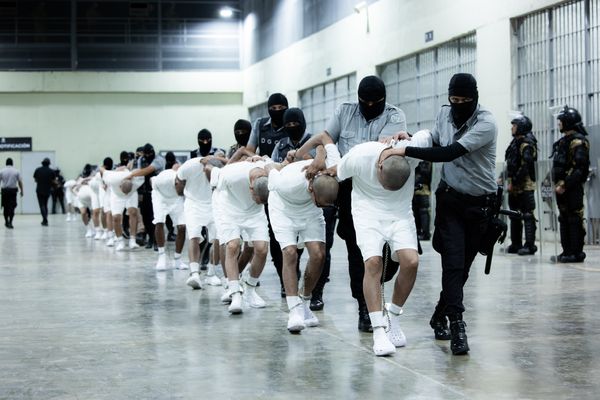
Woven, threaded, stitched and sewn, textile practice predates all recorded history; in fact some anthropologists speculate that textiles – made for warmth and shelter – may have been humanity’s first technology.
Manual textile-making has historically been a communal process, too, providing space for conversation, solidarity and, sometimes, resistance. Over the past decade, textile arts have been responsible for some of Australia’s most popular exhibitions. And yet as a form, textiles have a history of marginalisation in the high art world; associated with women, domesticity, First Nations traditions, and queer and class activism. They have been ignored or dismissed by the “pale, male and stale” art canon.
Radical Textiles at the Art Gallery of South Australia revels in its rejections of this bias and in its enthusiastic reverence for expert craft. Nearly 200 works are on show, gathered from more than 150 artists, designers and activists from Australia and abroad, and ranging from tapestries to trousers, union banners to sewn sculptures – disparate forms that communicate shared ideas about community, empathy and collective identity.
Curated by Rebecca Evans and Leigh Robb, and occupying the downstairs galleries of AGSA, the show opens with huge trade union banners that fill the walls of the high entrance room. Inside, august tapestries by William Morris & Co and the revolutionary French architect Le Corbusier keep company with drag costumes by Karen From Finance and Gabriella Labucci; while dilly bags woven by the Mparntwe (Alice Springs) artist Trudy Inkamala and her granddaughter Sheree Inkamala sit around the corner from the former SA premier Don Dunstan’s pink shorts – worn by him to parliament in November 1972 as a symbol of his government’s solidarity with the queer community.
The diversity of works, makers and meanings – including from names including Paul Yore, Sally Smart, Vivienne Westwood and Grayson Perry – reminds us that textiles, in their availability and range, are among the most accessible, ubiquitous and longstanding forms of artistic expression.
The juxtaposition of two works in particular underlines the form’s tremendous emotional power. During Covid lockdowns, the Sydney artist Nell sourced quilt squares from a call-out on social media, asking people to embroider the name of a woman they loved. The resulting work here is Nell Anne Quilt, in which Nell has stitched each panel into a wall-borne monument celebrating female solidarity. (The title pays homage to New Zealand artist Anne McCahon, who forwent her own creative ambitions to support her artist husband, Colin.)
On the opposite wall hangs another quilted work: local panels from the NAMES Project Aids Memorial Quilt. Begun in 1989 to commemorate South Australians lost to HIV/Aids, a panel reading “I will always love you Scott” evokes the devastating simplicity of grief. These are artefacts of two different social experiences of love, representing the experiences of two different communities, and yet such is the soft familiarity of a quilt that the love they record is sensory and palpable. You grieve for Scott, too.
The Australian designers Nicol & Ford appreciate the power of tactile memory. Their demicouture collections are known for engaging with art history and queer identity – and they archive their own relationship through clothing, too. What Katie-Louise was wearing for their first kiss. The dress she made for Lilian when Lilian transitioned. At home they keep suitcases full of these items.
“How often do people hold on to something of a loved one that’s passed?” Lilian says. For all the detail and sophistication of design, textiles remain “vehicles to people. It’s really, really important.”
So it registers as a human loss when Katie-Louise describes the encounters with young fashion students, who increasingly study design without learning the physical craft of making. The deliberate sensitivity of Nicol & Ford designs to the uniqueness of human bodies results from Katie-Louise’s training in patternmaking, cutting, tailoring – yet some schools are now helping students outsource their graduating portfolio collections for overseas manufacture.
Radical Textiles does not shy away from the relationship between textiles, mercantile trade and exploited labour. Modern channels of trade have been carved from brutal legacies of colonisation, which is referenced in the “African” wax print patterns the British-Nigerian artist Yinka Shonibare’s uses to decorate his Refugee Astronaut: a comment on the relationship between capitalism, ecological disaster and displacement. Nearby, the Indonesian artist Eko Nugroho speaks to the historical displacement that created those patterns: the batik technique used in Shonibare’s work was stolen from Nugroho’s own culture’s traditions in the 19th century, and commercially exported to west Africa by the colonising Dutch.
The exhibition suggests digitisation and internet culture are also driving distance between makers and the made. While technology has improved the tools and capacity of artists to create, the internet’s domination over our culture risks abstracting humanity from its conversations. The Melbourne artist Kate Just addresses this tension in her work by rendering online snapshots of feminist protest placards as knitted artworks, “rematerialising” ephemeral digital activism into tangible objects.
“We’re in this world where if you scroll on your phone, it’s like doom, violence, horror, speed … a constant influx of images,” Just says. It’s an experience that can overwhelm, demobilise and disempower. The physical act of knitting is the artist’s way of reconnecting and “putting those knitted images back” – not just into the museum but into social media for “temporal recalibration”.
The Trump election and the rise of rightwing authoritarianism in the west have been explicitly predicated on remarginalising the voices of women, unions, Indigenous peoples and queer communities. What this exhibition demonstrates is that the products of quilting, threading, sharing and stitching are not ideologically neutral, domestic decorations. They are the result of historical processes, local and global, and can embody acts of resistance that have defied and survived oppression through the ages.
Standing beneath the soft comfort of her quilt, Nell does not claim to know what lies ahead – but, when she reassures me “the resistance will be sensory”, I believe her.
Radical Textiles is open at the Art Gallery of South Australia, Adelaide, until 30 March 2024. Guardian Australia travelled to Adelaide as a guest of AGSA







